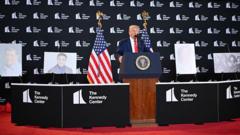Is the Smithsonian Shifting to Align with Trump's Vision?

The White House's Initiative for Smithsonian Content: A New Direction for American History
As the United States approaches its 250th birthday, a significant initiative is taking shape that aims to reshape the historical narrative presented by one of the nation’s most revered cultural institutions: the Smithsonian. This initiative, spearheaded by the White House, seeks to ensure that the exhibits and content within the Smithsonian align with the administration's vision of American history. The goal is to present a cohesive narrative that emphasizes "unity, progress, and enduring values that define the American story." This article explores the implications of this initiative, the motivations behind it, and the potential impact on the portrayal of American history.
Understanding the Initiative
The initiative was formally communicated in a letter from key White House officials, including Lindsey Halligan, Vince Haley, and Russ Vought, to Smithsonian Institution Secretary Lonnie Bunch. Within this correspondence, a clear directive emerged: to align the Smithsonian’s exhibitions with President Donald Trump’s executive order titled “Restoring Truth and Sanity to American History.” This executive order was introduced as a means to combat what the administration perceives as divisive narratives that detract from the idea of American exceptionalism.
Core Objectives of the Initiative
The primary objectives of this initiative can be summarized as follows:
- Promotion of Unity: The administration aims to present a unified narrative that fosters national pride.
- Focus on American Exceptionalism: Highlighting the positive aspects of American history while minimizing narratives perceived as divisive or critical of American values.
- Collaboration with Curators: While the White House intends to guide the overarching narrative, it has assured that day-to-day operations of curators and staff will remain unaffected.
The Significance of the 250th Anniversary
The 250th anniversary of the United States, set to occur in 2026, serves as a crucial backdrop for this initiative. The White House has expressed a desire for the Smithsonian to play a vital role in the celebrations, with particular emphasis on how American history is portrayed during this milestone. The request for a representative from the Smithsonian to work directly with the administration underscores the importance of this collaboration.
Concerns Over Historical Narratives
One of the critical components of this initiative is the administration's expressed concern over what it describes as a "divisive, race-centered ideology" influencing historical narratives. In the executive order, President Trump lamented the portrayal of American values as harmful and oppressive, suggesting that such narratives undermine the integrity of cultural institutions like the Smithsonian. This raises important questions about how history is interpreted and presented in public spheres.
The Role of the Smithsonian in American Culture
The Smithsonian Institution has long been a cornerstone of American cultural heritage, dedicated to preserving and portraying the nation's history through rigorous research and scholarly excellence. Its vast collections and exhibitions serve as a testament to the diverse tapestry of American experiences. However, the recent directive from the White House introduces a new layer of scrutiny over these exhibits, potentially steering them towards a more homogenized narrative.
Potential Impacts on Exhibitions and Content
With the White House's engagement, several areas within the Smithsonian are likely to undergo examination and potential reformation:
- Exhibition Text: The language used in exhibitions may be reviewed to ensure it aligns with the administration's vision.
- Online Content: Digital representations of American history will also be assessed for conformity with the new guidelines.
- Curatorial Processes: Internal curatorial practices may be influenced to reflect a more unified narrative.
- Artist Grants and Collections: The use of collections and funding for artists may be directed towards projects that align with the administration's historical perspective.
Response from the Smithsonian Institution
In response to the White House's letter, the Smithsonian has expressed a willingness to cooperate while maintaining its commitment to academic rigor and factual accuracy. This collaboration could lead to a complex relationship between the administration's objectives and the institution's long-standing principles of scholarly independence and integrity.
The Broader Implications for American History
This initiative raises critical questions about the direction of historical discourse in the United States. The careful crafting of narratives can significantly influence public perception and understanding of history. The White House's push for a more unified portrayal of American history may resonate with some audiences, while others may view it as an attempt to sanitize or oversimplify complex historical realities.
The Debate Over Historical Accuracy
Historically, narratives surrounding significant events in American history have been multifaceted and often contentious. The push for a singular narrative may overlook the complexities and diverse perspectives that enrich the understanding of the past. This raises the question: Can a single narrative ever encompass the entirety of a nation's history, or does it risk marginalizing vital aspects of the American experience?
Public Reception and Future Consequences
The public's reception of this initiative will likely be mixed. Supporters may appreciate a narrative that highlights pride and unity, while critics may voice concerns over the potential erasure of critical historical contexts. The consequences of this initiative could extend beyond the Smithsonian, influencing how history is taught in schools, represented in media, and understood in public discourse.
Conclusion: A Pivotal Moment for American History
As the United States prepares to celebrate its 250th anniversary, the initiative to align the Smithsonian's content with a specific historical vision presents a pivotal moment in the ongoing discourse surrounding American history. The interplay between government influence and institutional independence will shape the narratives that future generations engage with. This initiative prompts us to reflect on what it means to celebrate our history and how we can honor the complexity of the American experience.
FAQs
What is the purpose of the White House's initiative with the Smithsonian?
The initiative aims to align the Smithsonian's exhibits with the administration's vision of American history, emphasizing unity and American exceptionalism while minimizing divisive narratives.
How will this initiative affect the Smithsonian's exhibitions?
The initiative may lead to reviews of exhibition text, online content, and curatorial processes to ensure they reflect the desired narrative set forth by the White House.
What are the concerns regarding historical narratives in this initiative?
Concerns center around the potential for a homogenized narrative that overlooks the complexities and diverse perspectives inherent in American history.
As we stand on the brink of a significant anniversary, how do you think we should approach the narratives that define our history? Should we prioritize unity, or is it essential to embrace the complexities of our past? #AmericanHistory #Smithsonian #CulturalNarratives
Published: 2025-08-13 04:47:33 | Category: Trump GNEWS Search



